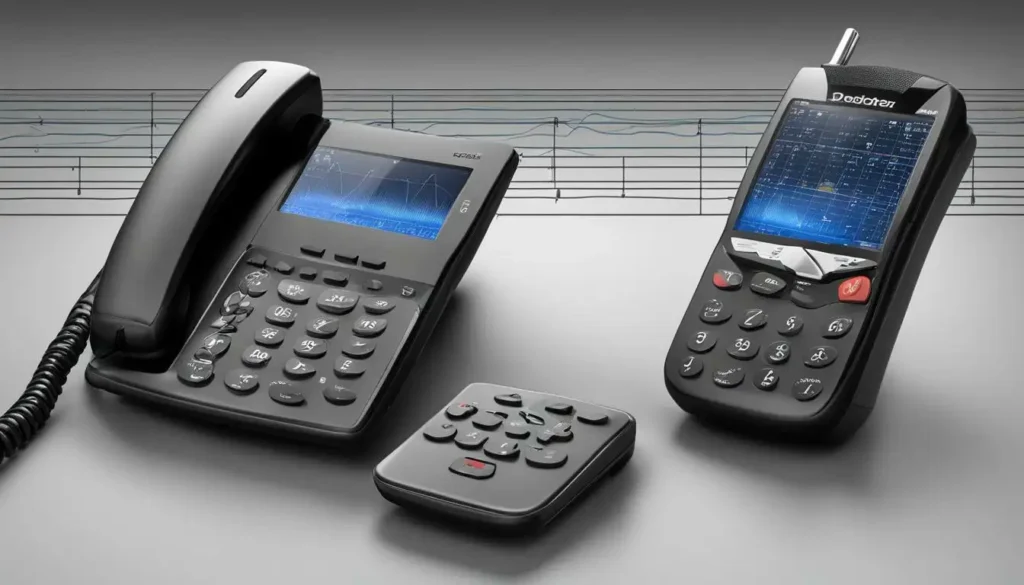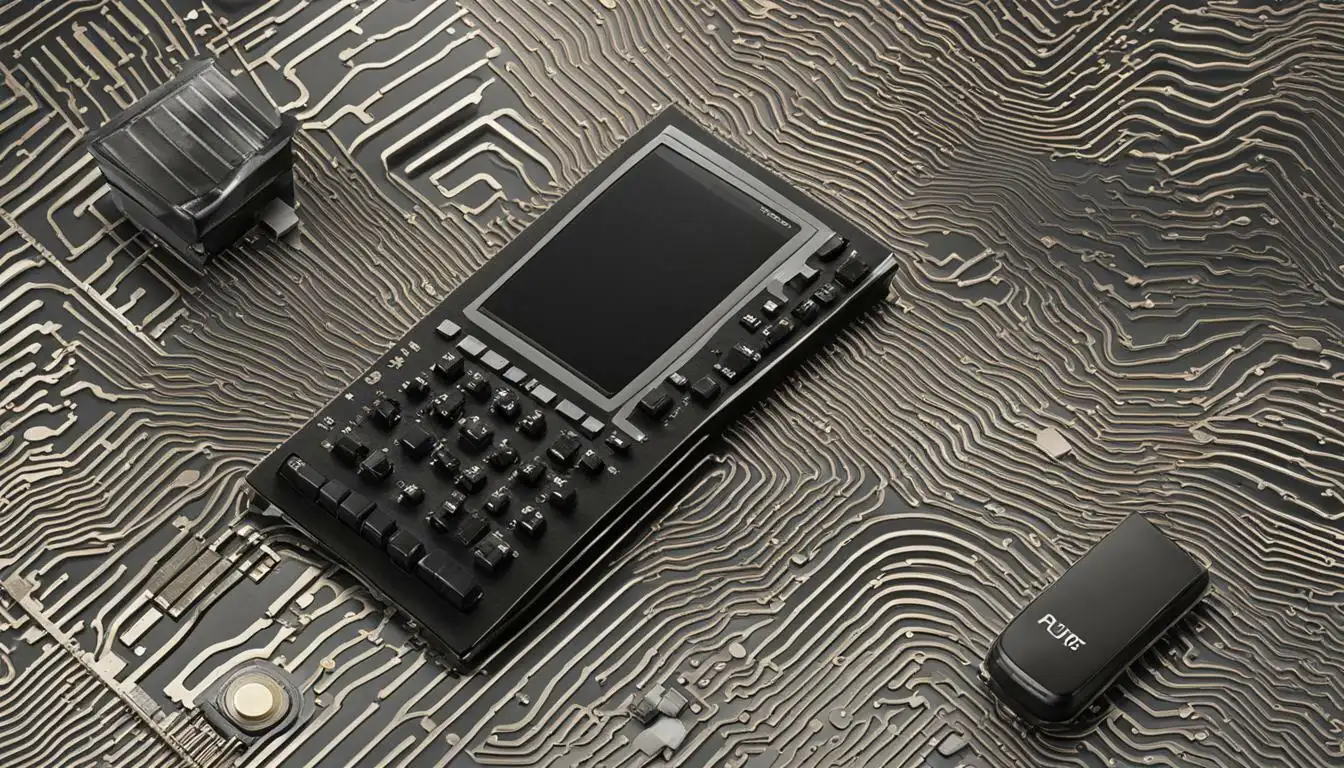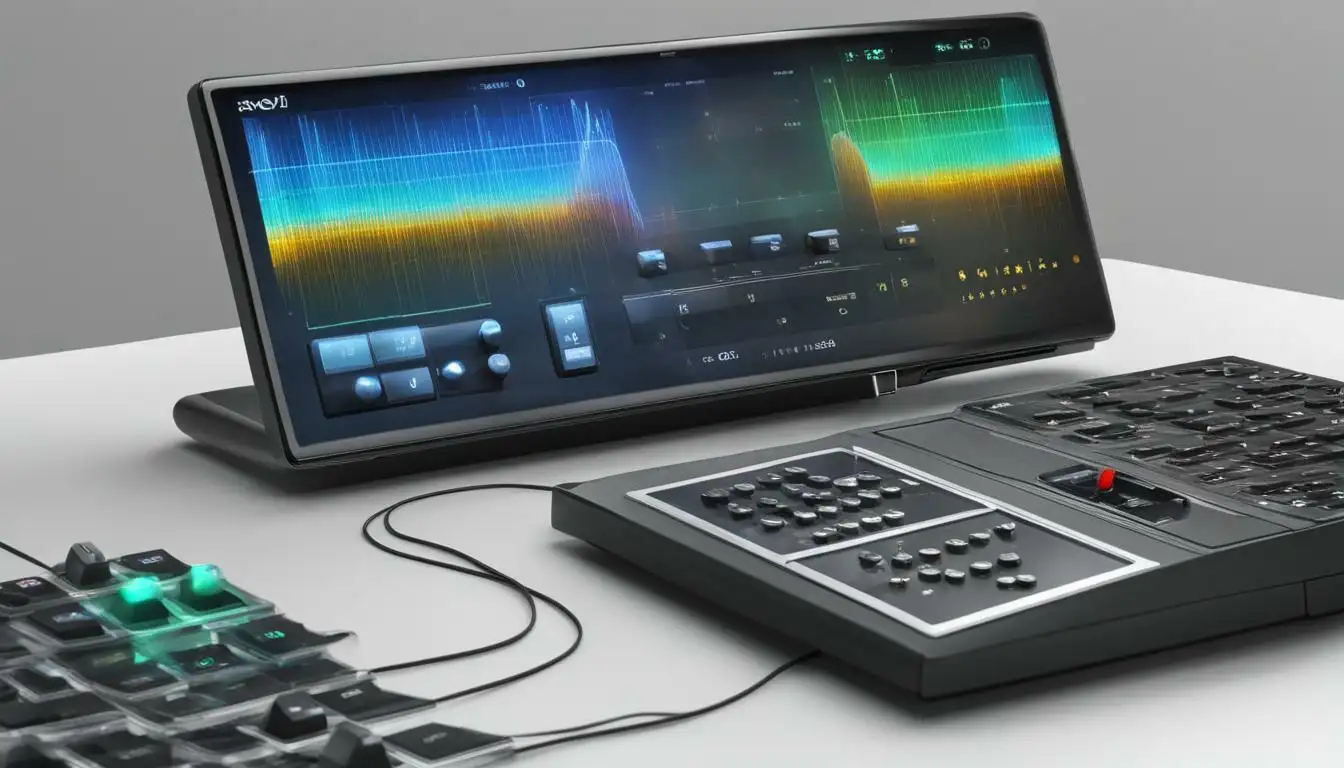DTMF tones, also known as dual-tone multi-frequency tones, play a vital role in telecommunications systems and can be found in many of our everyday devices. These tones are used to encode digits for transmission between the customer and the central office in telephony systems.
When you press a button on a telephone keypad, it generates two tones at specific frequencies. One tone comes from a low group of frequencies, while the other tone comes from a high group of frequencies. These tones are combined to form the DTMF tone, which represents the digit you’ve pressed.
Understanding DTMF tones involves knowing how they are generated and decoded. The tones can be decoded using filters and Fourier transform techniques, which extract the encoded information from the tones.
Originally used for control signals in telephone systems, DTMF tones have expanded their applications to include telephone menus, transaction systems, and other everyday devices. These tones enable efficient communication and control in various technologies.
Key Takeaways:
- DTMF tones are dual-tone multi-frequency tones used in telecommunications systems.
- Each button on a telephone keypad generates two tones at specific frequencies.
- These tones can be decoded using filters and Fourier transform techniques.
- DTMF tones have applications beyond traditional telephone systems, including telephone menus and transaction systems.
- They play a vital role in enabling efficient communication and control of various technologies.
The Functionality of DTMF Tones
DTMF tones serve a crucial purpose in telecommunications by encoding digits and facilitating communication between users and central offices. These tones consist of a combination of two frequencies, one from a lower group and one from a higher group. When a button on a telephone keypad is pressed, it generates these specific frequencies, allowing the transmission of encoded information.
Telephony systems rely on DTMF tones to transmit control signals between customers and central offices. These tones are used to encode digits, enabling users to make phone calls, access voicemail, navigate through telephone menus, and carry out various other functions. The encoded information is transmitted as a series of DTMF tone pairs, each representing a specific digit or command.
The detection and decoding of DTMF tones involve the use of filters and Fourier transform techniques. These methods extract the encoded information from the received signal, allowing for accurate interpretation and response. By analyzing the frequencies present in the signal, telecommunication devices can decipher the intended digits or commands and carry out the appropriate actions.
| Usage of DTMF Tones: | Significance of DTMF Tones: |
|---|---|
| Telephone systems | Efficient communication |
| Telephone menus | Streamlined user interaction |
| Transaction systems | Secure and convenient transactions |
DTMF Tones and Their Application
DTMF tones find application beyond traditional telephone systems. They are widely used in everyday devices such as telephone menus, transaction systems, and even security systems. These tones enable efficient communication and control, making them essential in various technologies that rely on user input and response.
The significance of DTMF tones in our everyday lives cannot be understated. They play a crucial role in facilitating communication and interaction in modern telecommunications systems. As technology continues to advance, the applications and innovations related to DTMF tones are likely to expand, promising a future filled with improved efficiency and convenience.
In the realm of telecommunications, DTMF tones are utilized for transmitting control signals and can be detected using specialized techniques. These tones, also known as dual-tone multi-frequency tones, play a crucial role in enabling efficient communication between customers and central offices in telephony systems. Each button on a telephone keypad corresponds to a unique combination of two tones generated at specific frequencies.
DTMF tones were initially developed as a means to send control signals within telephone systems. However, their usefulness extends far beyond traditional telephony. They are commonly used in telephone menus, where the tones allow users to navigate through various options and select desired actions. Additionally, DTMF tones are leveraged in transaction systems, where customers input numeric information through touch-tone keypads for secure and efficient processing.
One of the key techniques used to detect DTMF tones is the Goertzel algorithm. This fast and efficient algorithm enables the identification of specific DTMF tones within a signal, allowing for accurate decoding and processing. By applying this algorithm, telecommunications systems can effectively recognize and respond to user inputs, enhancing the overall user experience.
DTMF Tone Detection
DTMF tone detection is a critical aspect of telecommunications systems. By analyzing the frequencies of the received tones, telephony devices and applications can interpret user inputs and execute the desired actions. Techniques such as digital signal processing, filtering, and Fourier transform are employed to identify and extract the encoded information from the DTMF tones.
Overall, DTMF tones are an integral part of modern telecommunications, facilitating efficient communication and control in various technologies. Their versatility and widespread use make them indispensable in everyday devices, from traditional telephones to advanced transaction systems. As technology continues to evolve, DTMF tones will likely continue to play a significant role in shaping the future of communication.
| DTMF Tone | Low Group Frequency (Hz) | High Group Frequency (Hz) |
|---|---|---|
| 1 | 697 | 1209 |
| 2 | 697 | 1336 |
| 3 | 697 | 1477 |
| 4 | 770 | 1209 |
| 5 | 770 | 1336 |
| 6 | 770 | 1477 |
Understanding DTMF Tone Generation
The generation of DTMF tones involves producing specific frequencies based on the buttons pressed on a telephone keypad. Each button on the keypad is associated with two tones, one from a low group of frequencies and one from a high group of frequencies. These tones are essential for encoding digits and transmitting them between the customer and the central office in telephony systems.
To generate DTMF tones, the telephone keypad utilizes a combination of two frequencies from each group. When a button is pressed, the corresponding tones are simultaneously produced. For example, pressing the number ‘1’ on the keypad generates a tone consisting of a 697 Hz frequency from the low group and a 1209 Hz frequency from the high group.
This process allows for easy recognition and differentiation of the different digits being pressed. The specific frequency combinations associated with each button are standardized and widely used in telecommunications and everyday devices. Understanding the generation of DTMF tones is crucial to comprehending how these tones are employed for communication and control purposes.
| Button | Low Group Frequency | High Group Frequency |
|---|---|---|
| 1 | 697 Hz | 1209 Hz |
| 2 | 697 Hz | 1336 Hz |
| 3 | 697 Hz | 1477 Hz |
| 4 | 770 Hz | 1209 Hz |
| 5 | 770 Hz | 1336 Hz |
| 6 | 770 Hz | 1477 Hz |
| 7 | 852 Hz | 1209 Hz |
| 8 | 852 Hz | 1336 Hz |
| 9 | 852 Hz | 1477 Hz |
| * | 941 Hz | 1209 Hz |
| 0 | 941 Hz | 1336 Hz |
| # | 941 Hz | 1477 Hz |
Decoding DTMF Tones
Decoding DTMF tones involves applying filters and Fourier transform techniques to extract the transmitted digits. These tones are generated by pressing buttons on a telephone keypad, each corresponding to a specific combination of two tones from low- and high-frequency groups.
When a DTMF tone is received, it can be separated into its constituent frequencies using filters. This process helps isolate the individual tones for further analysis. Then, by using Fourier transform techniques, the frequency components of the DTMF tones can be accurately determined.
Once the frequencies are identified, the corresponding digits can be decoded. This process relies on a reference frequency table that maps each combination of tones to the corresponding digit. By comparing the detected frequencies to the reference table, the transmitted digits can be determined.
Decoding DTMF Tones: A Step-by-Step Process
- Apply filters to isolate the individual tones within the received DTMF signal.
- Use Fourier transform techniques to accurately determine the frequency components of the isolated tones.
- Compare the detected frequencies to a reference frequency table to identify the corresponding digits.
Decoding DTMF tones is an essential process in telecommunications and various applications where reliable digit transmission is required. By understanding how DTMF tones are decoded, we gain valuable insight into the inner workings of telephony systems and their applications.
Besides traditional telephone systems, DTMF tones find application in telephone menus, transaction systems, and a range of everyday devices. These tones, also known as dual-tone multi-frequency tones, are used to encode digits for transmission between the customer and the central office in telephony systems. Each button on a telephone keypad generates two tones at specific frequencies, one from a low group of frequencies and one from a high group of frequencies.
The functionality of DTMF tones goes beyond their initial purpose of transmitting control signals in telephone systems. In telephone menus, for example, DTMF tones enable users to navigate through different options by pressing the corresponding buttons on their keypads. Similarly, transaction systems utilize DTMF tones to facilitate secure and efficient communication between customers and service providers.
Whether it’s entering a PIN, making a payment, or accessing voicemail, DTMF tones play a crucial role in ensuring seamless interaction with various everyday devices. From security systems and home automation to interactive voice response systems, DTMF tones enable efficient communication and control in a wide range of technologies.
| Applications | Examples |
|---|---|
| Telephone Menus | Banks, customer support systems |
| Transaction Systems | ATMs, e-commerce platforms |
| Security Systems | Access control and alarm systems |
| Home Automation | Smart lighting and temperature control |
| Interactive Voice Response Systems | Automated phone surveys, appointment scheduling |
As technology continues to evolve, the application of DTMF tones is likely to expand further. With advancements in voice recognition and artificial intelligence, we may witness the integration of DTMF tones in cutting-edge technologies such as smart assistants and autonomous vehicles. The prospects of DTMF tones hold the potential for enhancing communication and control in ways we have yet to imagine.
The Goertzel Algorithm and DTMF Tone Detection
The Goertzel algorithm provides a fast and efficient method for detecting specific DTMF tones within a signal. This algorithm is commonly used in telecommunications systems and other applications where tone detection is required. By analyzing the frequency components of a signal, the Goertzel algorithm can accurately identify the presence of DTMF tones.
When applied to DTMF tone detection, the Goertzel algorithm calculates the energy at specific frequencies associated with each button on a telephone keypad. It utilizes a mathematical formula that is optimized for detecting these predetermined frequencies. By comparing the energy levels at these frequencies to predefined thresholds, the algorithm can reliably identify the presence of DTMF tones.
The Goertzel algorithm’s efficiency lies in its ability to perform tone detection in real time with minimal computational resources. This makes it suitable for applications with limited processing capabilities, such as embedded systems and mobile devices. Additionally, the algorithm’s accuracy and speed make it highly reliable for detecting DTMF tones in noisy environments, ensuring reliable communication.
Table: Frequencies of DTMF Tones
| Row Frequency (Hz) | Column Frequency (Hz) |
|---|---|
| 697 | 1209 |
| 770 | 1336 |
| 852 | 1477 |
| 941 | 1633 |
The Goertzel algorithm’s widespread usage in DTMF tone detection highlights its importance in telecommunications and other related technologies. Its efficient and accurate tone recognition capabilities ensure robust communication systems that rely on DTMF tones for various applications, including telephone menus, transaction systems, and more.
Overall, the Goertzel algorithm plays a crucial role in the successful detection of DTMF tones, enabling efficient and reliable communication in diverse technological applications.
Harmonics and Chords: Connecting DTMF Tones and Music
Despite some similarities to musical concepts like harmonics and chords, there is no clear theory linking DTMF tones to the mystery of the statue code mentioned in the source. However, the connection between DTMF tones and music is still fascinating to explore.
DTMF tones are composed of two frequencies, one from a low group and one from a high group. These frequencies are carefully chosen to be easily distinguishable and free from interference. When played together, they create a unique sound that can be associated with each button on a telephone keypad.
Just like musical notes, DTMF tones can be combined to form chords. For example, pressing multiple buttons simultaneously on a telephone keypad generates a combination of tones that can be heard as a chord. This connection to music adds an intriguing aspect to the functionality of DTMF tones.
Although there is no direct application of DTMF tones in music composition or performance, understanding the underlying principles can provide insight into the nature of sound and how it is used in various technological applications. By exploring the relationship between DTMF tones and musical concepts like harmonics and chords, we gain a deeper appreciation for the complexity and versatility of sound in our everyday lives.
| DTMF Tone | Frequencies (Hz) |
|---|---|
| 1 | 697, 1209 |
| 2 | 697, 1336 |
| 3 | 697, 1477 |
| 4 | 770, 1209 |
| 5 | 770, 1336 |
| 6 | 770, 1477 |
| 7 | 852, 1209 |
| 8 | 852, 1336 |
| 9 | 852, 1477 |
| 0 | 941, 1336 |
| * | 941, 1209 |
| # | 941, 1477 |
The Significance of DTMF Tones in Our Everyday Devices
DTMF tones play a significant role in our everyday devices, enabling efficient communication and control in technologies like smartphones, home automation systems, and more. These tones, also known as dual-tone multi-frequency tones, are used to transmit encoded digits between the customer and the central office in telephony systems.
Each button on a telephone keypad generates two tones at specific frequencies, one from a low group of frequencies and one from a high group of frequencies. These tones can be decoded using filters and Fourier transform techniques, allowing for the extraction of the encoded information.
Initially used for transmitting control signals in telephone systems, DTMF tones have found applications beyond traditional telephony. They are commonly used in telephone menus, allowing users to navigate through various options, and in transaction systems for secure and efficient processing of payments.
One notable algorithm used for detecting specific DTMF tones within a signal is the Goertzel algorithm. This algorithm provides a fast and efficient method for tone detection, ensuring reliable communication and control in various technologies.
| Applications of DTMF Tones: |
|---|
| Smartphones |
| Home automation systems |
| Telephone menus |
| Transaction systems |
In conclusion, DTMF tones serve as a vital component of our everyday devices, facilitating efficient communication and control. Their usage extends beyond traditional telephony, finding applications in smartphones, home automation systems, and various other technologies. Through advancements such as the Goertzel algorithm, these tones continue to play a crucial role in enabling seamless interactions between users and their devices.
Exploring the History of DTMF Tones
To fully understand the significance of DTMF tones, it is essential to explore their history and evolution within the field of telecommunications. DTMF tones, also known as dual-tone multi-frequency tones, were first introduced in the 1960s as a way to transmit control signals in telephone systems. The idea behind this technology was to replace the older, less efficient rotary dialling system.
DTMF tones revolutionized the way we interacted with telephones. Instead of manually dialling numbers using a rotary dial, users could now simply press buttons on a keypad to generate the desired tones. Each button on a telephone keypad corresponds to a specific combination of two tones, one from a low group of frequencies and one from a high group of frequencies. These tones are then decoded by the receiving end of the call to determine the dialled digits.
Over the years, DTMF tones have found applications beyond traditional telephone systems. They are commonly used in telephone menus, transaction systems, and various other everyday devices. The ability to encode and decode DTMF tones quickly and accurately has made them an integral part of modern communication and control systems.
The Evolution of DTMF Tones
The development of DTMF tones has undergone several advancements since its inception. From the early days of using mechanical switches to generate the tones, the technology has progressed to electronic circuitry that can generate the tones more efficiently. The introduction of microcontrollers in telecommunications systems further improved the generation and detection of DTMF tones.
Today, DTMF tones continue to play a vital role in our everyday lives. They enable us to navigate telephone menus, authenticate transactions, and control various devices. As technology continues to evolve, so too will the applications and capabilities of DTMF tones, opening up new possibilities for efficient communication and control.
| Year | Milestone |
|---|---|
| 1960s | Introduction of DTMF tones in telephony systems as a replacement for rotary dialling |
| 1970s | Advancements in electronic circuitry for more efficient generation and detection of DTMF tones |
| 1980s | Integration of microcontrollers in telecommunications systems, further enhancing DTMF technology |
| Present | Continued use of DTMF tones in telephone menus, transaction systems, and everyday devices |
Future Prospects of DTMF Tones
As technology continues to evolve, DTMF tones are likely to witness new advancements and applications, paving the way for exciting possibilities in the future. These tones have a long-standing history in telecommunications, but their potential goes beyond traditional telephone systems. With their ability to encode digits and transmit control signals, DTMF tones have become an integral part of our everyday devices and communication networks.
In the coming years, we can expect to see further innovations in the generation and detection of DTMF tones. Advancements in signal processing techniques and hardware technology will enable more efficient tone generation and accurate detection. This will enhance the reliability and functionality of telephony systems and other applications that rely on DTMF tones.
Moreover, as the Internet of Things (IoT) continues to expand, DTMF tones may find new applications in various smart devices and interconnected systems. From home automation to industrial control systems, the use of DTMF tones can simplify communication and enable seamless control.
Exploring the Possibilities
One area of interest is the integration of DTMF tones with voice assistants and voice recognition technology. By combining the convenience of voice commands with the reliability of DTMF tones, users can experience more seamless interactions with their devices. This integration can have significant implications for accessibility and hands-free operation in various domains.
Additionally, the exploration of the connection between DTMF tones and music opens up intriguing possibilities. As we comprehend the similarities and differences between these tones and musical notes, we may discover new ways to create unique audio experiences and enhance musical compositions.
With ongoing research and development, the future of DTMF tones holds immense promise. From improved telephony systems to innovative applications in emerging technologies, these tones will continue to play a vital role in shaping the way we communicate, control, and interact with our digital world.
Conclusion
DTMF tones are a fundamental aspect of telecommunications and our everyday devices, enabling efficient communication, control, and interaction with technology. These dual-tone multi-frequency tones serve the purpose of encoding digits for transmission in telephony systems. Each button on a telephone keypad generates two tones at specific frequencies, one from a low group and one from a high group. By utilizing filters and Fourier transform techniques, these tones can be decoded, allowing for the extraction of encoded information.
Initially used for sending control signals in telephone systems, DTMF tones have found applications beyond traditional telephony. They are widely deployed in telephone menus, transaction systems, and other everyday devices, offering convenient and efficient user interaction. The Goertzel algorithm plays a crucial role in detecting specific DTMF tones within a signal, enabling fast and accurate identification.
While there is an interesting connection between DTMF tones and musical concepts such as harmonics and chords, there is no clear theory linking DTMF tones to any specific code or mystery. However, their significance in our everyday lives cannot be overlooked. DTMF tones play a vital role in enabling efficient communication and control in various technologies, ensuring seamless interaction between users and their devices.
As we look towards the future, the advancement of DTMF technology holds promising prospects. With ongoing innovations and potential applications, DTMF tones are likely to continue evolving and finding new applications in telecommunications and other fields. The history of DTMF tones showcases their growth and widespread adoption, and it is fascinating to speculate on what new developments may lie ahead.
















